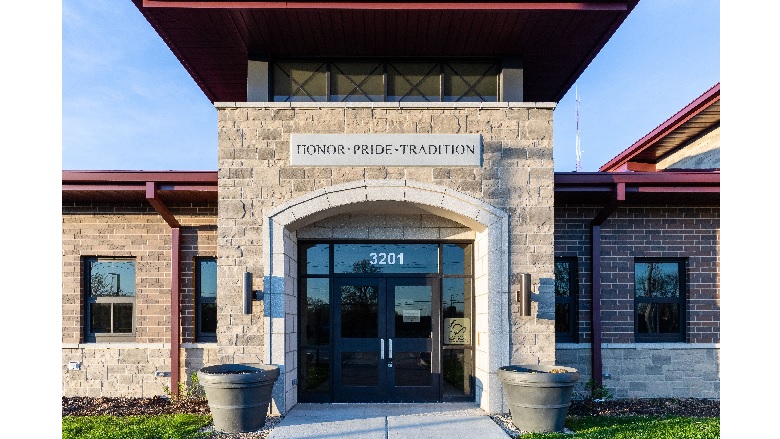The city of Rolling Meadows, Illinois, recently debuted Fire Stations #15 and #16, located approximately 5 miles apart. The goal of the much-anticipated project was to optimize services and response times to best serve the community. The Naperville, Illinois-based architecture firm Healy, Bender, Patton & Been won the bid for the contract to design both structures. Founded in 1935, the firm has maintained its original mission statement, “To be a trusted adviser; to bring practical, cost-conscious design to our clients and in doing so, never lose sight of our commitment to client service and bringing the best ideas to the table.” Senior architect and project manager Scott Rihel explained the origins of the dual venture.
“Every fire station design is a response to the owners’ requirements and needs,” Rihel said. “As we develop the design, it evolves based on the configuration of the site, the visibility of the building, the aesthetic of the surrounding neighborhood and a host of other factors.”
Since this was a design/build project, Rihel and his team partnered with RC Wegman Construction on both sites. As part of their services, Rihel’s team completed a needs assessment to determine the ideal locations as well as structural configurations to allow for optimal deployment times and getting the first responders out of the firehouses as quickly as possible.
“For this project, we worked directly with staff at the fire station to determine specific needs,” Rihel noted. “Both designs included three apparatus bays, a full kitchen, fitness area, bunk room and changing room. In addition, Station #15 plans included a suite of administrative offices.”
Because of its headquarters designation, Station #15 was designed to stand out, so the front entrance was designed as an iconic element with materials that looked permanent and appropriate for a fire station. Rihel turned to the experts at Northfield/Echelon to explore masonry options for the project.
“We had worked extensively with Northfield/Echelon on past projects, keeping up with new materials and research and development advancements,” the architect recalled. “Once the territory rep introduced us to Waterford Stone, we realized it was perfect for this project. And we chose Cordova Stone for the accent details.”
Waterford Stone is designed to evoke a natural, time-honed look with its beautiful, antiqued edges and textured face. A diverse array of colors and sizes are available to suit any design need. Its integrated color allows for a consistent, easy-to-follow blended pattern.
“We wanted the stone material we utilized to mimic some of the surrounding residential and commercial structures,” Rihel noted. “We were trying to pick up on that local character, so we wanted to complement the neighboring buildings in both color and pattern.”
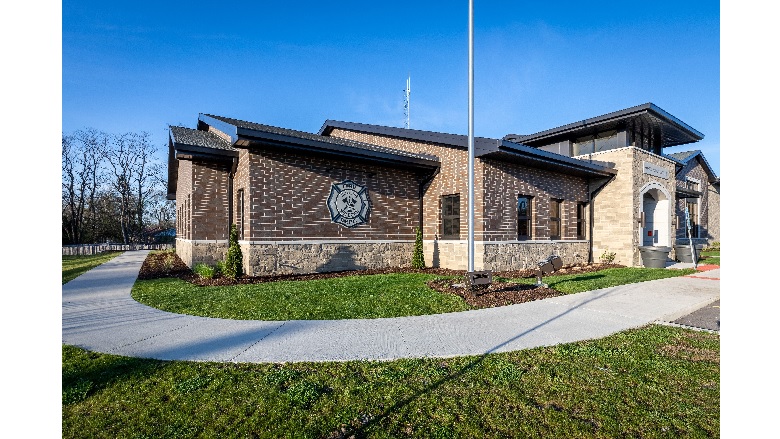
Photo courtesy of Echelon
After selecting different colors of both products from the Northfield manufacturing plant, Rihel and his team were able to view the materials on-site and determine how well each complemented the neighboring structures. They eventually settled on Waterford Stone in London Gray to complete the dominant ashlar pattern used for both stations and Cordova Stone in Graphite for the trim aspects.
“It really fits in with the character of the city,” Rihel added. “There are several monuments throughout the city, and the materials complemented that look.”
Rob Solfisburg, Project Manager for Joe’s Masonry, oversaw the installation of both Echelon products on the Fire Station #16 site. He had a similar reaction to the aesthetic appeal of the Echelon products.
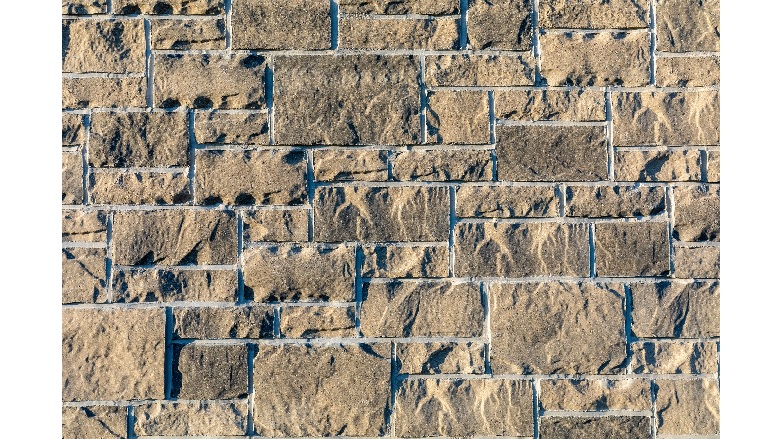
Photo courtesy of Echelon
“It’s a beautiful building,” Solfisburg said. “The architectural design afforded us an opportunity to use masonry in its finest form. This building will have a long lifespan. It gives strength to the municipality it represents.”
The versatility of Waterford Stone allowed for a great deal of design flexibility. The hand-cut stone gave Rihel the option to use a combination of load-bearing and non-load-bearing materials.
“We used the full thickness stone from ground up—25-30 feet high,” Rihel explained. “Where it wasn’t bearing on the ground, we used a thin non-load-bearing material that hung off the side.”
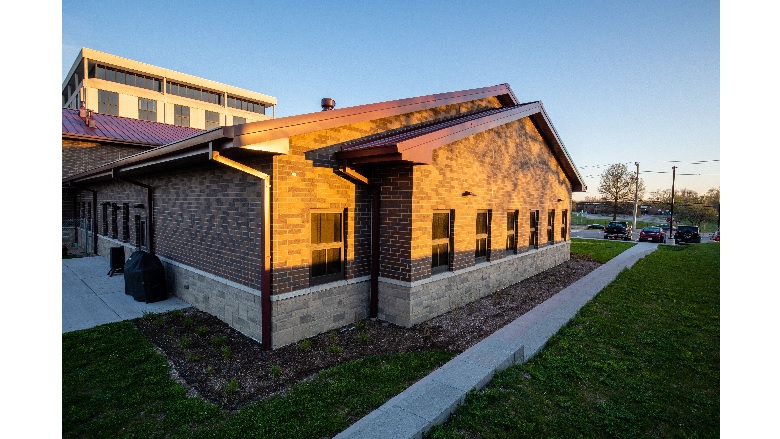
Photo courtesy of Echelon
Although most of the stone veneer on this project was full depth, full bed stone was pre-cut at the Northfield plant to an adhered veneer, which allowed for a wall-to-wall seamless transition where needed.
Cal Riegle, estimator and project manager with Midwest Masonry, contracted for the Station #15 job. “Waterford Stone tied everything together; it was easy to install alongside the other masonry units that we used,” he commented. “The design and skilled construction resulted in a remarkable, finished building.”
Cordova Stone concrete masonry units were used for the windowsills, tower sills, trim around doors and to create the apparatus bay borders for both fire stations, as well as the entrance doors. “The arched openings provided a bold, striking focal point of the building,” Solfisburg noted.
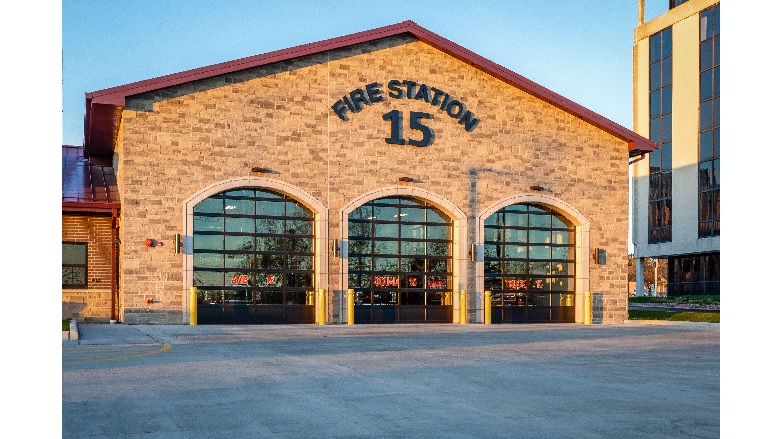
Photo courtesy of Echelon
The Cordova high-density, pre-finished architectural stone cladding achieves the look of natural stone by incorporating all-natural aggregates and recycled content, delivering the prestigious appearance that has remained a desired look for centuries. It is known for its durability, design flexibility, ease of installation and beautiful limestone appearance, all of which allow for an elegant and enduring look.
When the new fire stations were completed in 2020, the community response was enthusiastic. “The feedback has been overwhelmingly positive—the city loves it and the firemen love it,” Rihel commented.
The fine craftsmanship of both fire stations reflects the firefighters’ creed, commemorated on an engraved plaque located directly above the front entrance archway of Station #15: Honor*Pride*Tradition.
